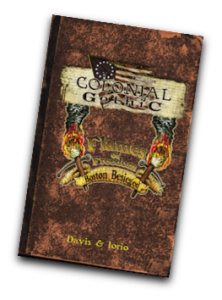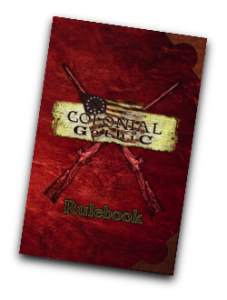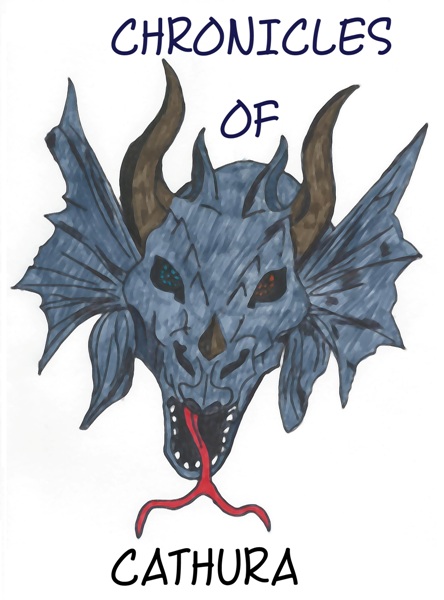Flames of Freedom
Flames of Freedom is a campaign series for Colonial Gothic published by Rogue Games.
By Graeme Davis

Welcome to the sixth Designer’s Diary, a regular column where designers are given the opportunity to take readers on an in-depth ride through the design and development process of their system, setting, or product.
Designer’s Description
Flames of Freedom is a campaign series for Colonial Gothic that follows the course of the Revolutionary War and uncovers a secret history beneath the recorded events. In addition to dealing with plots by British agents – supernatural and otherwise – the Heroes are faced with local mysteries, red herrings, and the results of simple human nature.
The campaign is in four parts, following the course of history. The first volume, Boston Besieged, is of course set in and around Boston, and leads up to the point when Washington placed captured guns from Fort Ticonderoga on Dorchester Heights, threatening the Royal Navy ships in Boston harbor and forcing the British to abandon the city. In Colonial Gothic, the Americans had some supernatural help – but so did the British.
The second volume, working title The Philadelphia Affair, is set during the Second Continental Congress immediately following the Siege of Boston. A thread from that adventure leads the Heroes to Philadelphia, where they investigate a disappearance while the British threat to the city grows. The final two volumes are set in New York and the southern colonies respectively.
In addition to the adventure itself, each book includes a detailed sourcebook on the adventure’s location, covering history, politics, and locations and offering a selection of adventure seeds that the GM can use either with the campaign of outside of it.

Purpose
When I first came on board as line developer, Richard and I talked about how to strengthen Colonial Gothic and a campaign series was something that occurred to both of us. Richard already had a number of ideas – in fact, The Philadelphia Affair was already partly written – and we quickly sketched the outlines of the rest of the campaign.
I worked for Games Workshop as a writer, editor, and de facto line developer for Warhammer Fantasy Roleplay in the late 1980s, and I saw first-hand what the Enemy Within campaign did for the game. We both agreed that a campaign series would give the game a solid focus that the same number of unrelated supplements could not.
Influences
I sometimes describe Colonial Gothic as “the American Revolution re-imagined by H. P. Lovecraft and Dan Brown,” but there are many influences. Washington Irving is one – there is an adventure based on The Legend of Sleepy Hollow – as well as historical novels like The Last of the Mohicans. Movies like The Patriot, The Brotherhood of the Wolf, and the miniseries John Adams have also been great influences. And roleplaying games that have influenced Colonial Gothic include Call of Cthulhu and Warhammer Fantasy Roleplay.
Research
Both Richard and I are big fans of history, alternative history, and conspiracy theory, so a lot of the research had already been done through our two lifetimes of reading. For my part, I brushed up on my knowledge of the Revolutionary War, which isn’t widely taught in British schools. Hmm – I wonder why! I had already done some basic research during my work on the video game Empire: Total War, but needed to fill in some details. I also reread some Dan Brown and dug out my old copy of The Holy Blood and the Holy Grail, since Freemasons were an influential group on both sides of the Revolutionary War and Templars figure somewhat in the storyline as well. Apart from that, I had already researched mysteries and paranormal events in the Thirteen Colonies for the Colonial Gothic Gazetteer, so it was down to researching the locations themselves.
Art Direction
An important part of the art direction for Colonial Gothic is to maintain a sense of time and place. Because of that, we like to use period illustrations as much as possible and fill in with art that is historically correct. Artist Jeff Preston has brought a great deal to the line, and so has cartographer Gabriel Brouillard. Gabriel also wrote the New France supplement.

Gaming Experience
The original concept for Colonial Gothic was Cthulhu 1776. We wanted to create the same sense of dread that Lovecraft and Call of Cthulhu do better than almost anyone else. But we also wanted to use the conspiracy angle that has served Warhammer Fantasy Roleplay so well. After all, the period has some great players, including the Freemasons and the British East India Company.
Comparison
The Enemy Within was a great inspiration for both of us – Richard and I first met while working the Hogshead booth at GenCon years ago, back when Hogshead was publishing first-edition WFRP material – and of course Masks of Nyarlathotep is another classic campaign. But as far as I know, no one has done anything similar in a historical context. Paizo’s Adventure Path series are the most prominent prominent roleplaying campaign lines these days, and Flames of Freedom is a different beast entirely.
Development Process
It varies slightly from book to book. For Boston Besieged we worked in parallel: I researched and wrote the Boston sourcebook right after the Colonial Gothic Gazetteer, while Richard was developing the adventure. I put the two together, expanded the sourcebook a little to do full justice to the locations Richard used in the adventure, and the assembled whole went into editing. For The Philadelphia Affair, Richard had already done a good deal of research on the city and the Continental Congress, so he wrote both parts and I acted as editor. Going forward, we expect to develop the storylines jointly. Although Richard is in Illinois and I’m in Virginia, we work together very closely by phone and email, kicking ideas around and knocking them into shape.




